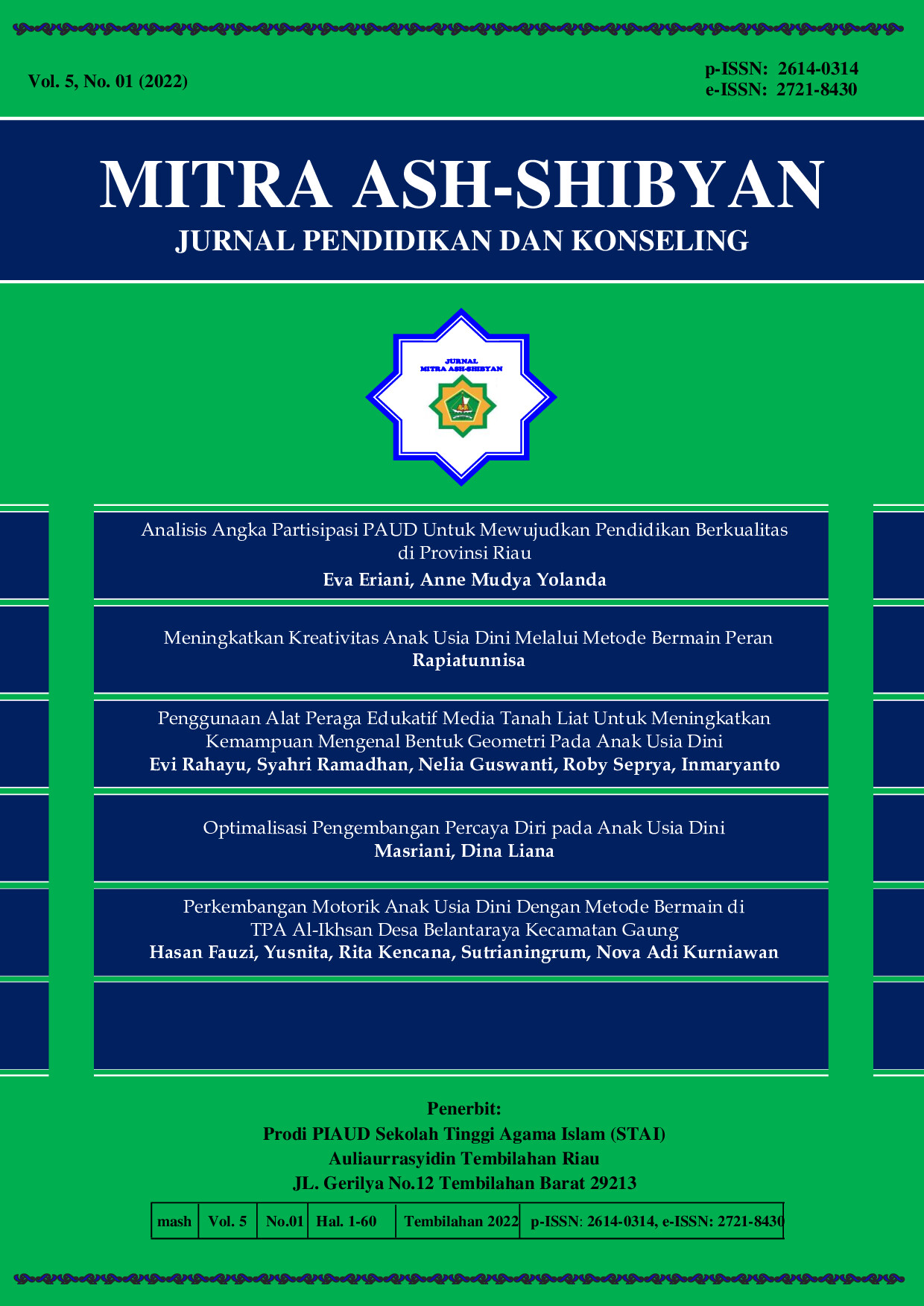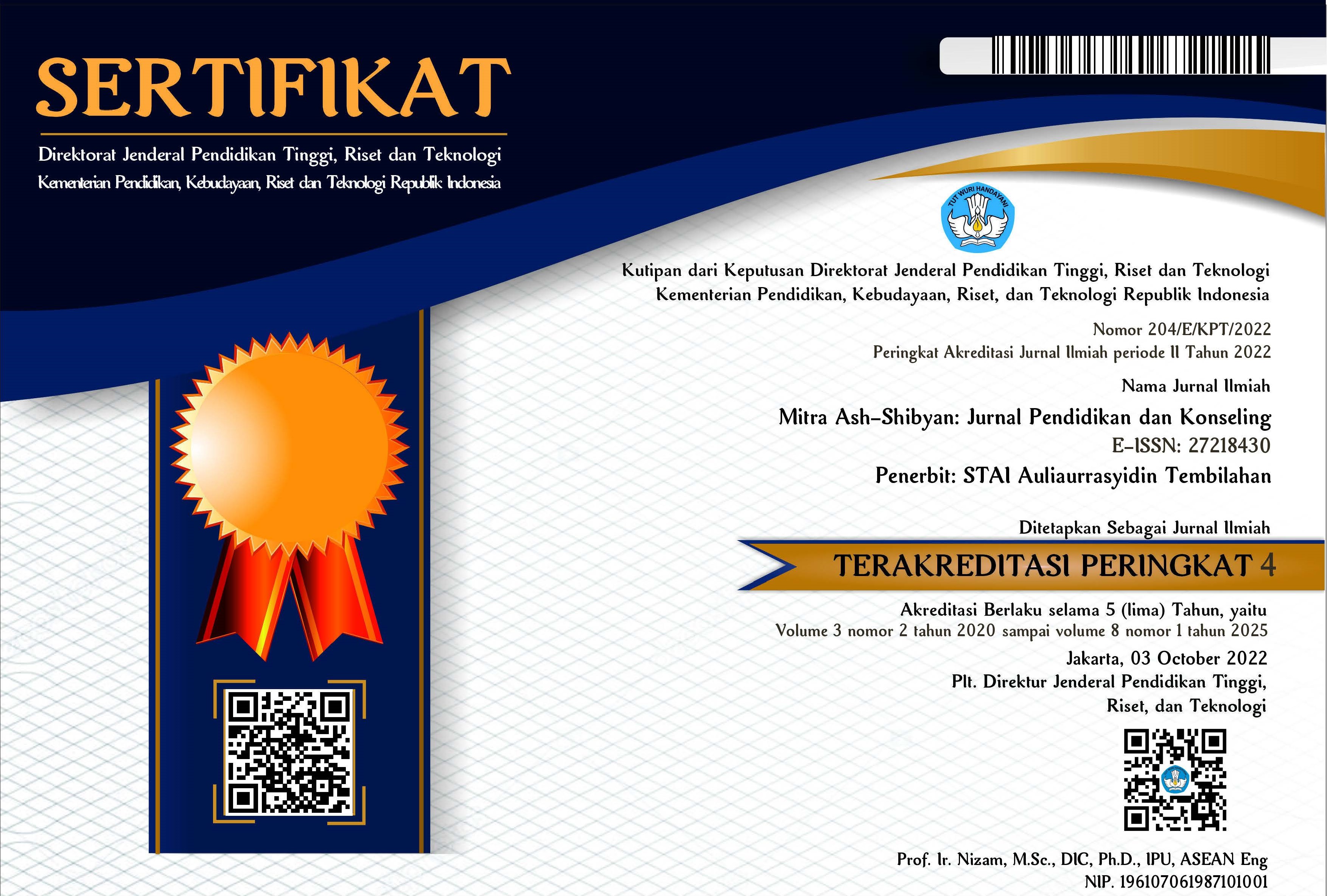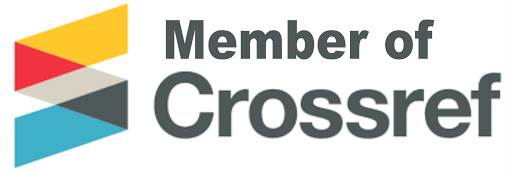Meningkatkan Kreativitas Anak Usia Dini Melalui Metode Bermain Peran
DOI:
https://doi.org/10.46963/mash.v5i01.423Keywords:
Creativity, Role Playing, Early ChildhoodAbstract
Creativity in children is indicated by independence, confidence, and skills in problem-solving. The pre-research confirmed there are students with immature creativity. This was seen in those who were not confident and did not believe in self-reliance during the learning process. This study aims to determine the extent to which the role playing method can improve the creativity of early childhood at PAUD Nurul Hilal. This study belongs to classroom action research. The subjects of this study were all students of PAUD Nurul Hilal (16 students). The data were collected through the use of tests, observation sheets, and field notes. They were then analyzed by using the P = f/N x 100 to identify the students’ creativity and the P= (post rate - base rate)/ base rate x 100% to clarify the improvement of the students’ creativity. The results show the students’ creativity in the pre-cycle was 24 (30%) “Not good”, the cycle I was 46 (57.5%) “Sufficient”, and 75 (93.75%) “Very good” in cycle II. These infer the role-playing method can improve the students’ creativity of PAUD Nurul Hilal, Sub-district of Batang Tuaka.
Downloads
References
Agusniatih, A., & Monepa, J. M. (2019). Keterampilan Sosial Anak Usia Dini (teori dan metode perkembangan). Tasik Malaya: Edu Publisher.
Amelia, L., & Marsella, A. (2018). Meningkatkan kemampuan Interpersonal Anak Melalui Metode Bermain Peran Dengan Menggunakan Boneka Jari Pada Pada Anak TK B2 Di Paud Save The Kids Banda Aceh. Jurnal Buah Hati, 5(2), 81–102.
Asmawati, L. (2014). Perencanaan Pembelajaran PAUD. Bandung: PT. Remaja Rosdakarya.
Eriani, E., & Dimyati. (2019). Fantasy Gymnastic as an Active and Imaginative Learning Model to Children ’ s Gross Motor. Atlantis Press, 296(Icsie 2018), 408–411. https://doi.org/10.2991/icsie-18.2019.76
Isjoni. (2011). Model Pembelajaran Anak Usia Dini. Bandung: Alfabeta.
Juniarti, F., & Jumiatin, D. (2018). Mengembangkan Kecerdasan Interpersonal Melalui Metode Bermain Peran Pada Anak Usia Dini. Jurnal Ceria, 1(5), 1–6.
Khoerunnisa, N. (2015). Optimalisasi Metode Bermain Peran dengan Menggunakan Alat Permainan Edukatif dalam Mengasah Percaya Diri Anak Usia Dini. Lentera, XVIII(1), 77–91.
Masganti, S., Eriani, E., Dimyati, & Nugraha, A. (2016). Pengembangan Kreativitas Anak Usia Dini. Medan: Perdana Publishing.
Mulyani, N. (2018). Perkembangan Anak Usia Dini. Yogyakarta: Gava Media.
Mulyasa. (2017). Manajemen PAUD. Bandung: PT. Remaja Rosdakarya.
Nurani, Y., & Mayangasri, T. (2017). Pengembangan Model Kegiatan Sentra Bermain dalam Mengembangkan Kreativitas Anak Usia Dini. Jurnal Pendidikan Anak Usia Dini, 11(2), 386–400. https://doi.org/10.21009/JPUD.112.15
Rachmawati, Y., & Kurniati, E. (2011). Strategi Pengembangan Kreativitas pada Anak Usia Taman Kanak-Kanak. Jakarta: Kencana.
Rahmalina. (2017). Metode Bermain Peran Terhadap Kreativitas Anak Usia Dini 4-6 Tahun. Jurnal Pendidikan PAUD, 02(1), 11–23.
Yulia, N. (2019). Meningkatkan Kreativitas Melalui Metode Bermain Peran Pada Anak Kelompok B. In Seminar Nasional PGPAUD (hal. 207–2017). Banten: Unitirta.
Downloads
Published
Issue
Section
License
Authors who publish with this journal agree to the following terms:
1. Copyright on any article is retained by the author(s).
2. The author grants the journal, right of first publication with the work simultaneously licensed under a Creative Commons Attribution shareAlike 4.0 International License that allows others to share the work with an acknowledgment of the work’s authorship and initial publication in this journal.
3. Authors are able to enter into separate, additional contractual arrangements for the non-exclusive distribution of the journal’s published version of the work (e.g., post it to an institutional repository or publish it in a book), with an acknowledgment of its initial publication in this journal.
4. Authors are permitted and encouraged to post their work online (e.g., in institutional repositories or on their website) prior to and during the submission process, as it can lead to productive exchanges, as well as earlier and greater citation of published work.
5. The article and any associated published material is distributed under the Creative Commons Attribution-ShareAlike 4.0 International License







2.png)



